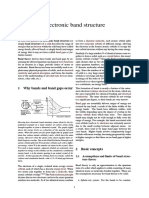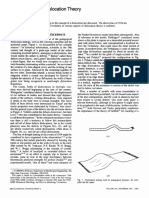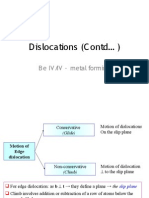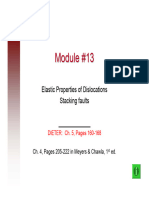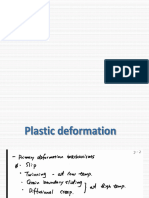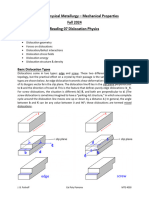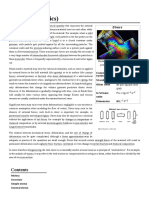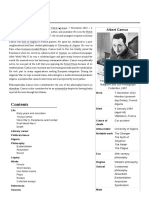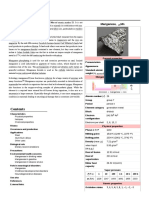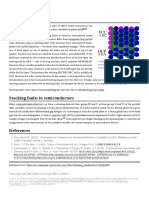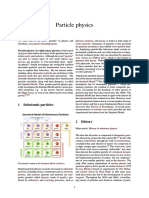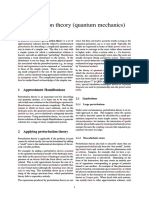0 ratings0% found this document useful (0 votes)
140 viewsBook
Dislocations
Uploaded by
Teka KamCopyright
© © All Rights Reserved
Available Formats
Download as PDF or read online on Scribd
0 ratings0% found this document useful (0 votes)
140 viewsBook
Dislocations
Uploaded by
Teka KamCopyright
© © All Rights Reserved
Available Formats
Download as PDF or read online on Scribd
You are on page 1/ 20
Elementary
Dislocation
Theory
JOHANNES WEERTMAN
NORTHWESTERN UNIVERSITY
and
JULIA R. WEERTMAN
THE MACMILLAN COMPANY
COLLIER-MAOMILLAN LIMITED, LONDON
To Julia and Bruce
© coryricur, JOHANNES WEERTMAN, 1964
All rights reserved. No part of this book may be reproduced
or transmitted in any form or by any means,
clectronic or mechanical, including photocopying,
recording or by any information storage and retrieval
system, without permission in writing from the Publisher,
‘Sixth Printing, 1971
rary of Congress catalog card number: 64-23889
THe MAcMILLAN Company
866 Tump Avenue, New York, New York 10022
CoLtrer-MAcMILtan CANADA, Lrp., Toronto
Printed in the United States of America
Macmillan Series in Materials Science
Editors: morris x. FINE
JOHANNES WEERTMAN
JULIA R. WEERTMAN
Fine, Morris E.: Introduction to Phase Transformations
in Condensed Systems
Wayman, C. M.: Introduction to the Crystallography
of Martensitic Transformations
Weertman, Johannes and Weertman, Julia R.:
Elementary Dislocation Theory
Macmillan Series in Materials Science
Elementary
Dislocation
Theory
Preface
This book was written to be used in a one-semester or one-quarter
course on dislocation theory at the advanced undergraduate level
(junior or senior year). This book grew out of experience gained in
teaching such course at Northwestern University. The material in
our text covers mainly the basic, fundamental. properties of disloca-
tionsincrystals. Noattempt has been made to treat the application of
dislocations to theories of work hardening, creep, internal friction, etc.
‘The material in the text is that which must be mastered by any student
before he can attempt to study and understand the various “applied”
dislocation theories which have been developed to explain the multi-
tude of structure sensitive phenomena of crystals. It is difficult in a
one-quarter or one-semester course to teach, except in a very super-
ficial way, both basic and applied dislocation theory. It was for this
reason that, we have attempted here to develop only the fundamentals
of dislocation theory. This more modest coverage of the field of dis-
location theory has the compensating advantage that the fundamental
properties of dislocations can be examined in sufficient detail to give
the student a good mastery of the subject.
Since advanced engineering and science students usually have
studied calculus, vector analysis, and elementary thermodynamics we
have assumed a knowledge of these subjects on the part of the student.
No other special knowledge is presumed. For example, the treatment
of the stress-strain field of the dislocation is preceded in the text by a
treatment: of elasticity theory, a topic to which thé average student
has had very limited exposure.
A large number of problems are given in this text. ‘The student is
encouraged to work out as many ofthese as he can, Dislocation theory
v
VI ELEMENTARY DISLOCATION THEORY
is that type of subject which can be understood thoroughly only after
contemplation of many problems.
We aro indebted to Dr. W. J. McG. Tegart for reading the manu-
script of this book.
®
CONTENTS
Pole Mechanism
Twinning
Emissary Dislocations
Stacking Fault Tetrahedron
Peierls Stress
Simplified Calculation of the Peierls Stress of a Screw
Dislocation
Self-Energy
Peierls Force
cuarTeR 6. Image Forces, Interactions with Point Defects and
Other Topics
Image Forces
Image Dislocation
Image Force Near an Interface Separating Material of
Different Elastic Constants
Point Defect Interactions—Cottrell-Pinning
Suzuki or Chemical Interaction
“Other Interactions of Alloying Atoms and Dislocations
Stress Induced Order (Schoeck-Snoek Effect)
Long-Range Order
Short-Range Order and Clustering
Drift of Pinned Dislocations at High Temperatures and
Low Stresses
Small Angle Grain Boundaries
Symmetric Tilt Boundary
Energy of a Simple Tilt Boundary
Nonsymmetric Tilt Boundary
General Tilt Boundary
Symmetric Twist Boundary
Nonsymmetric Twist Boundary
General Small Angle Boundary
Curvature of a Crystal Lattice
Origin of Dislocations
Thermal Stresses
Impurity Atoms
Vacancy and Interstitial Collapse
Screw Dislocation Mechanism
Whiskers
APPENDIX
INDEX
139
141
146
147
149
153
156
168
168.
168
170
173
178
181
181
184
184
187
187
189
189
192
195
195
195
198
198
198
199
201
209
211
ey
eee eet ae
I. Description
of a Dislocation
Discovery of the Dislocation
The dislocation is an object worthy of study. Its existence permits
metals to be plastically deformed with. éase, a circumstance upon which
our modern technology is so dependent, .‘The dislocation has served
man ever since he first developed metal implements. The dislocation
also permits nonmetallic crystalline materials to be plastically de-
formed. In fact at suitable temperatures a nonmetallic crystalline
material usually can be deformed as easily is a piece of metal. Thus
the dislocation plays a commanding role in those grandest of all
deformations on earth: the upheavals that have produced the moun-
tain ranges and the continents themselves, Dislocations within grains
of ice permit high mountains and high-latitude land masses to rid
themselves, through the plastic flow of glaciers and ice sheets, of their
ever-accumulating blanket of snow.
The ease with which metals can be deformed was the crucial exper-
imental observation that lead to the discovery of the dislocation,
While this property was known to prehistoric man, the fact that it is a
very unusual property was not fully realized until many millennia later.
By the second decade of this century the atomistic and periodic
nature of crystalline substances was fully established through the use
of x-rays. Once it was known that orystals are made up of a periodic
array of atoms, the magnitude of the shear stress required to produce
plastic deformation in a crystal could be calculated easily. Consider
Figure 1-1. Part (a) shows two-dimensional, close-packed layers of
atoms. One atom in each layer is drawn solid so that the motion
1
ELEMENTARY DISLOCATION THEORY
———
(a)
Shear displacement in a perfect lattice.
Ficore 1-1.
e
~+~—___..
a ne ge
DESCRIPTION OF A DISLOCATION 3
through (a) and (b) to (c) can be followed more easily. In (b) a shear
Stress large enough to force each horizontal layer of atoms up and
over the layer beneath it is applied. Finally, in (©) the atoms are
brought to positions equivalent to those in (a). If the shear stress
is removed in (0), there is no reason for the atoms to retum to
their positions in (a). The deformation is permanent; it is a plastic
deformation which has not altered the crystalline nature of the
lattice,
The lattice of Figure 1-1 becomes unstable when it approaches the
Position ‘shown in (b). Thus the shear stress required to bring the
lattice to this state is the stress at which Permanent, or plastic defor.
mation becomes possible. ‘This shear stress is the theoretical shear
strength of the crystal. Its magnitude can be estimated rolighly by
the angle shown. It is measured in radians (360° — Sx radians). If
u is the shear modulus of the orystal, the theoretical shear strength
is of the order of 16, or approximately 4/3. (A brief review of elas.
about 3 x 1011 dynes /om? (108 dynesjom? = 1 bar x 1Kg/om? ~ 14 psi
the theoretical strength is of the order of 1011 dynes/em?, The’ the-
cretical shear strength of ice, with a modulus of around 3 x 1010 dynes/
cm?, is of the order of 1019 dynes/om®, Yet annealed single crystals
of aluminum can be deformed at stresses as low as 3 3108 dynes/om?,
and ice in glaciers is known to deform at stress levels as low as
108 dynes/cm®, ‘Therefore a discrepancy of many orders of magnitude
can exist between the theoretical and observed shear strengths of
crystals. (It should be noted, however, that at relatively low tem-
Peratures metal specimens previously subjected to cold-working and
4 ELEMENTARY DISLOCATION THEORY
deformation. This imperfection is the dislocation, the subject of this
book.*
Dislocations were first seen in the early fifties by Hedges and
Mitchell, who used a decorating technique to make them visible in
silver-halide crystals. Dislocations are now commonly observed under
the electron microscope by means of the transmission technique. This
technique was first used for the study of dislocations in 1956 by Hirsch,
Horne, and Whelan and independently by Bollmann.
Description of a Dislocation Line
‘The best description of a dislocation is obtained from a study of
its formation in the crystalline lattice. Consider Figure 1-2. In the
center is the starting material, a perfect, undeformed simple cubic
lattice. (A simple cubic lattice is used for the sake of clarity. The
only substance known to crystallize in this lattice structure is the metal
polonium.) Cut this lattice along any of the planes indicated in the
auxiliary cubes. Let the atoms on one side of the out shift in a
direction parallel to the cut surface through a distance, relative to the
corresponding atoms on the other side, equal to one atom spacing.
Then rejoin the atoms on either side of the cut. The new, distorted
lattice is shown in the outer figures. The lattice structure itself actually
is almost perfect except near the lines AA of the various figures. Tho
line imperfections AA in the lattice are dislocation lines.
‘The three types of dislocation lines are shown in Figure 1-2. If
the atoms over the cut surface are shifted in a direction perpendicular
to the line 4A, an edge dislocation is created in the lattice; if the
shift is parallel to 4A, a screw dislocation is produced; if the shift
is neither parallel nor perpendicular to AA but rather is at some arbi-
trary angle, a dislocation line having the characteristics of both an
edge and a screw dislocation is placed into the lattice. This third
type is called a mixed dislocation.
An edge dislocation also can be made simply by inserting an extra
half plane of atoms into the lattice, as shown in Figure 1-3, or by
removing a half plane of atoms. The edge dislocation line is the
easiest to visualize in the lattice. It coincides with the edge of the
extra half plane of atoms.
‘*Actually the concept of the dislocation wes introduced into the continuum
elasticity theory in the early 1900's by Volterra and by Timpe.
TO
=<
a
W
—>
" Frcure 1-2, The cre:
d é :
” Figur 1-3. Edge dislocation,
ew
a screw, and a mixed dislocation,
a
f an edge,
ation of
6 ELEMENTARY DISLOCATION THEORY é
In the process of creating the screw dislocation shown in Figure 1-2,
the atom planes pérpendicular to the dislocation line are turned into
aspiral ramp. The screw dislocation itself is the pole about which the
spiral ramp circles, Figure 1-4 shows these spiraling atomic planes.
Ficure 1-4, Screw dislocation.
The atom planes are analogous to the floor of a type of modern multi-
storied parking garage. In such a garage one drives from street level
onto a ramp with a slight upward gradient. By driving continuously
on this ramp in a circle about the central pole, one eventually emerges
onto the roof of the garage, many stories above street level. Similarly,
in Figure 1-4 a very small bug could walk from one side of the crystal
to another without ever leaving the atomic plane. The screw dis-
location shown in Figure 1-4 is right-handed. A screw dislocation
also can be left-handed. .
In Figure 1-2 the boundary of the out within the crystal is a straight
line. A curved interior boundary could have served just as well. A
cut with a circular boundary is shown in Figure 1-6. The rejoining
of the atoms on either side of this cut produces a dislocation line in
the form of a quarter of a circle. This dislocation line cannot be
characterized either as pure edge, pure screw, or as mixed with a
fixed proportion of screw and edge character. Where the circular
dislocation line emerges from the orystal at point A, it is pure edge in
character since here the dislocation line lies perpendicular to the direc-
tion in which the atoms on the cut were shifted. Similarly, where
the dislocation emerges at point B, it is pure screw in character since
here the dislocation lies parallel to the direction of shift. Between
~
DESCRIPTION OF A DISLOCATION a
ZIT
Ficure 1-5. Mixed dislocation with varying edge and screw components,
these two points the dislo:
cation is mixed, but the proportion of screw
and edge character varies continuously with the direction of the dis-
location line,
A dislocation line can be made in the form of a closed loop rather
than as a line that terminates at the erystal surface. Such a loop,
the atoms in this plane would look like those shown in (b). Thus
8 ‘ELEMENTARY DISLOCATION THEORY
(a)
(b)
(c)
Ficure 1-6.
both the segments AB and DO are edge dislocations but they are of
“opposite sign.” ‘That is, one segment has its extra half plane of
atoms above the out and the other has its extra half plane of atoms
below the cut surface. If the crystal were sliced along the plane FFFF,
DESCRIPTION OF A DISLOCATION 9
the atoms would look as shown in-(c). Dislocation segments BC and
AD are sorew dislocations; they also have opposite sign. It is obvious
that one segment is a right-handed and the other is a left-handed
screw dislocation.
The dislocation loop could have been made in any arbitrary shape,
The only requirement is that the loop be closed. (It will by loft as
interior of a crystal.) If a circular dislocation loop is made by shifting
the atoms parallel to the plane of the loop, the characte of each
dislocation segment of the loop varies continuously from Pure edge
to mixed to screw dislocation, as shown in Figure 1-7. Tt should be
mixed Screw mixed
direction
of shift
ane
e000
mixed Screw mixed
Ficune 1-7. Dislocation loop.
noted that segments on opposite sides of the loop are the same type
of dislocation but have opposite sign.
Prismatic Dislocation Loop
In the previous section a dislécation loop was created by making a
cut along a plane and then shifting the atoms on either side of the
The shift of atoms on each side of the cut surface thus is perpendicular
fo the surface. Figure 1-8a illustrates the creation of a eireular die
location loop by this method. In Figure 1-8b we see the arrangement
10 ELEMENTARY DISLOCATION THEORY
FE
(a)
Froure 1-8. Prismatic dislocation loop.
of the atoms on # plane HEHE that slices the crystal in two. The
two segments of the dislocation loop that intersect the plane EEEE
obviously are pure edge dislocations which are opposite in sign. There
is an important difference between the orientations of the edge dis-
locations of Figure 1-8b and those in the similar Figure 1-6b. One
set of dislocations is rotated 7/2 with respect to the other.
If instead of slicing the crystal in two by the plane EEEE we had
chosen the plane FFFF, we would have found the arrangement of
the atoms to be that shown in Figure 1-8c. It can be seen that the
dislocation segments are identical to those in Figure 1-8b. In fact
every segment: of the dislocation loop of Figure 1-8 is a pure edge
dislocation. This result is in sharp contrast to our observations
DESCRIPTION OF A DISLOCATION i
concerning the dislocation loops of Figures 1-6 and 1-7, which have
proments varying in character from pure edge to pure screw. The
Instead of inserting an extra disk of material one atomic layer thick
between the cut surfaces of Figure 1-8, we eould just as well have
Temoved such a disk from the crystal and then rejoined the atoms
on either side of the cut. If the latter procedure had ben followed,
the prismatic loop would resemble the drawing of Figure 1-9.
Fioune 1-9. Section through prismatic loop of opposite sign to
. loop of Figure 1-8,
Motion of Dislocations
The motion of dislocations leads to plastio deformation, For
example, consider the pair of straight edge dislocations shown in
Migure 1-10. (The edge dislocations are represented here by their
einaas
Ficune 1-10. Slip produced by motion of two edge dislocations,
conventional symbol . The upright part of the 1 sign denotes
the extra half plane of atoms and the bottom, horizontal segment is
the slip plane.) ‘These dislocations, which are of opposite sign, move
across the crystal in the opposite direction. When the two dis.
locations pass out of the crystal, a step is produced on eithes side.
12 ELEMENTARY DISLOCATION THEORY
(IE the lattice contains many edge dislocations that move out of the
crystal, the resultant deformed crystal will resemble the drawing of
Figure 1-11.) The end result is equivalent to that produced by sliding
Ficure 1-11. Slip produced by motion of many edge dislocations.
all the atoms on one side of the plane containing the two dislocation
lines over those on the other side through a distance of one atom
spacing. We know that in a perfect lattice a stress of the order of
u/8 is needed to move all the atoms on one side of a plane over the
remaining atoms. If dislocations are present in a crystal, it will take
only the stress required to move a dislocation to cause the atoms to
undergo the same displacement. Thus if a crystal contains disloca-
tions, and #f the dislocations move easily, the 105 discrepancy noted
between the theoretical and some experimentally measured shear
strengths may be explained.
Beginning students usually find the displacements produced by the
motion of screw dislocations rather confusing. Figure 1-12 shows a
Ficune 1-12. Slip produced by motion of two screw dislocations.
pair of straight left- and right-handed screw dislocations in the act
of moving out of the crystal. It should be noted that the shift of
atoms parallel to the plane in which a screw dislocation moves is per-
pendicular to the direction of motion of the screw dislocation. This
You might also like
- (Dislocations in Solids 1) F.R.N. Nabarro - Dislocations in Solids - Elastic Theory (1979, North-Holland Publishing Co)No ratings yet(Dislocations in Solids 1) F.R.N. Nabarro - Dislocations in Solids - Elastic Theory (1979, North-Holland Publishing Co)179 pages
- TH Fdil Ti Theory of Dislocation: 2.1 Introduction To DislocationsNo ratings yetTH Fdil Ti Theory of Dislocation: 2.1 Introduction To Dislocations222 pages
- Chapter 5b Crystal Imperfections DislocationsNo ratings yetChapter 5b Crystal Imperfections Dislocations99 pages
- Stress Fields and Energies of DislocationNo ratings yetStress Fields and Energies of Dislocation30 pages
- PPT5. SeptIITK - Crystal - Imperfections - DislocationsNo ratings yetPPT5. SeptIITK - Crystal - Imperfections - Dislocations92 pages
- Bonga University: Engineering Material (Meng2091)No ratings yetBonga University: Engineering Material (Meng2091)59 pages
- Chapter 5b Crystal Imperfections DislocationsNo ratings yetChapter 5b Crystal Imperfections Dislocations94 pages
- Chapter 5b Crystal Imperfections Dislocations PDFNo ratings yetChapter 5b Crystal Imperfections Dislocations PDF94 pages
- Materials Technology: BY A.Vinothkumar Department of Aerospace Engineering SRM UniversityNo ratings yetMaterials Technology: BY A.Vinothkumar Department of Aerospace Engineering SRM University90 pages
- A Brief History of Dislocation Theory - HirthNo ratings yetA Brief History of Dislocation Theory - Hirth6 pages
- 04 Plastic Deformation of Single-2020son01No ratings yet04 Plastic Deformation of Single-2020son01186 pages
- C7 Engineering Materials Metals: Prof. Dr. Rer. Nat. S. SchmauderNo ratings yetC7 Engineering Materials Metals: Prof. Dr. Rer. Nat. S. Schmauder72 pages
- Lecture - Strain Hardening Stages in FCC CrystalNo ratings yetLecture - Strain Hardening Stages in FCC Crystal40 pages
- Dislocations and Strengthening Mechanisms: 7 - 1 I N T R o D U C T I o NNo ratings yetDislocations and Strengthening Mechanisms: 7 - 1 I N T R o D U C T I o N16 pages
- Dislocation Stress Fields: Theory of DislocationsNo ratings yetDislocation Stress Fields: Theory of Dislocations17 pages
- Classical Theory of Crystal Dislocations From Iron to Gallium Nitride Hiroyasu Saka - The full ebook version is ready for instant download100% (1)Classical Theory of Crystal Dislocations From Iron to Gallium Nitride Hiroyasu Saka - The full ebook version is ready for instant download47 pages
- Plastic Deformation, Flow Stress and Formability100% (2)Plastic Deformation, Flow Stress and Formability35 pages
- How Does Plastic Deformation Happens? Lets Take Some Historical Background On How People Tried To Answer This QuestionNo ratings yetHow Does Plastic Deformation Happens? Lets Take Some Historical Background On How People Tried To Answer This Question40 pages
- Instant download Classical Theory of Crystal Dislocations From Iron to Gallium Nitride Hiroyasu Saka pdf all chapterNo ratings yetInstant download Classical Theory of Crystal Dislocations From Iron to Gallium Nitride Hiroyasu Saka pdf all chapter67 pages
- Lecture 5 - Crystal Defects-Dislocations - 2 PDF100% (1)Lecture 5 - Crystal Defects-Dislocations - 2 PDF53 pages
- MetE230 Chap9 Dislocations and Strengthening Mechanisms ToparliNo ratings yetMetE230 Chap9 Dislocations and Strengthening Mechanisms Toparli39 pages
- ESO 205 Nature and Properties of MaterialsNo ratings yetESO 205 Nature and Properties of Materials26 pages
- Yield Strength, Elastic Limit, and Ultimate StrengthNo ratings yetYield Strength, Elastic Limit, and Ultimate Strength4 pages
- MTE 4050 Reading 07 Dislocation PhysicsNo ratings yetMTE 4050 Reading 07 Dislocation Physics13 pages
- One Dislocations: Vacant Vacancy. InterstitialNo ratings yetOne Dislocations: Vacant Vacancy. Interstitial33 pages
- Chapter 3: Dislocations in Crystals: Young's ModulusNo ratings yetChapter 3: Dislocations in Crystals: Young's Modulus67 pages
- Stacking Fault: Stacking Faults in SemiconductorsNo ratings yetStacking Fault: Stacking Faults in Semiconductors1 page
- Simultaneous Equations: Teachers Teaching With Technology T ScotlandNo ratings yetSimultaneous Equations: Teachers Teaching With Technology T Scotland4 pages
- (Dislocations in Solids 1) F.R.N. Nabarro - Dislocations in Solids - Elastic Theory (1979, North-Holland Publishing Co)(Dislocations in Solids 1) F.R.N. Nabarro - Dislocations in Solids - Elastic Theory (1979, North-Holland Publishing Co)
- TH Fdil Ti Theory of Dislocation: 2.1 Introduction To DislocationsTH Fdil Ti Theory of Dislocation: 2.1 Introduction To Dislocations
- PPT5. SeptIITK - Crystal - Imperfections - DislocationsPPT5. SeptIITK - Crystal - Imperfections - Dislocations
- Materials Technology: BY A.Vinothkumar Department of Aerospace Engineering SRM UniversityMaterials Technology: BY A.Vinothkumar Department of Aerospace Engineering SRM University
- C7 Engineering Materials Metals: Prof. Dr. Rer. Nat. S. SchmauderC7 Engineering Materials Metals: Prof. Dr. Rer. Nat. S. Schmauder
- Dislocations and Strengthening Mechanisms: 7 - 1 I N T R o D U C T I o NDislocations and Strengthening Mechanisms: 7 - 1 I N T R o D U C T I o N
- Classical Theory of Crystal Dislocations From Iron to Gallium Nitride Hiroyasu Saka - The full ebook version is ready for instant downloadClassical Theory of Crystal Dislocations From Iron to Gallium Nitride Hiroyasu Saka - The full ebook version is ready for instant download
- How Does Plastic Deformation Happens? Lets Take Some Historical Background On How People Tried To Answer This QuestionHow Does Plastic Deformation Happens? Lets Take Some Historical Background On How People Tried To Answer This Question
- Instant download Classical Theory of Crystal Dislocations From Iron to Gallium Nitride Hiroyasu Saka pdf all chapterInstant download Classical Theory of Crystal Dislocations From Iron to Gallium Nitride Hiroyasu Saka pdf all chapter
- MetE230 Chap9 Dislocations and Strengthening Mechanisms ToparliMetE230 Chap9 Dislocations and Strengthening Mechanisms Toparli
- Yield Strength, Elastic Limit, and Ultimate StrengthYield Strength, Elastic Limit, and Ultimate Strength
- Chapter 3: Dislocations in Crystals: Young's ModulusChapter 3: Dislocations in Crystals: Young's Modulus
- Simultaneous Equations: Teachers Teaching With Technology T ScotlandSimultaneous Equations: Teachers Teaching With Technology T Scotland



